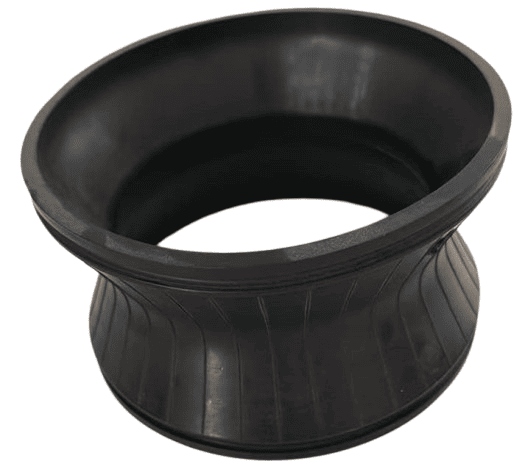Rubber sleeves are essential components in axial flow valves, providing vital sealing functions. But why is rubber used for this application, and how does it improve valve performance?
Rubber sleeves for axial flow valves1 offer excellent sealing, durability, and resistance to wear, heat, and chemicals. These properties make them ideal for demanding fluid control systems in industries like oil and gas, aerospace, and industrial machinery.

To understand the specific benefits of rubber sleeves in axial flow valves, let’s explore their properties, how they perform, and why they’re often the material of choice for such applications.
What is an Axial Flow Valve?
An axial flow valve directs fluid along the axis of the valve body. But what exactly makes this type of valve suitable for high-pressure and high-flow applications?
Axial flow valves control the direction and pressure of fluid by utilizing a flow path that follows the axis of the valve body. Rubber sleeves enhance their sealing and durability, ensuring smooth operation.
Axial flow valves are designed to manage high-pressure and high-volume fluid flows. The key characteristic of these valves is that fluid moves along the axis of the valve, rather than through perpendicular openings like in other valve types. This design helps minimize fluid turbulence and ensures smoother flow, which is especially important in applications like fluid transport and industrial machinery.
In axial flow valves, the rubber sleeve plays a critical role in sealing and protecting the valve’s inner components. The sleeve prevents leaks and ensures the valve operates effectively under high pressure. Without the rubber sleeve, the valve’s performance would be compromised, and there would be a higher risk of failure due to leakage or wear. The rubber used in these sleeves must meet strict durability standards to ensure long-term functionality.
Properties of Rubber Sleeves for Axial Flow Valves
Rubber sleeves used in axial flow valves are selected for their unique properties, which help these valves perform optimally. Some of the most important characteristics of these rubber sleeves include:
- Elasticity: Rubber's flexibility allows it to expand and contract under pressure, maintaining a tight seal even in fluctuating fluid conditions.
- Heat Resistance: Rubber sleeves must withstand high temperatures, especially in industrial and aerospace applications, where valves often come into contact with hot fluids.
- Chemical Resistance: Rubber material needs to resist chemical corrosion, particularly in industries like oil and gas, where valves deal with harsh chemicals.
- Wear Resistance: The rubber sleeve must be durable enough to endure the constant flow of fluids and movement without degrading or wearing out quickly.
These properties ensure that the rubber sleeves maintain their sealing ability, even under extreme pressure and environmental conditions.
Why is Rubber Used in Axial Flow Valves?
Rubber is used in axial flow valves primarily for its ability to provide an effective seal while offering resistance to chemicals, heat, and wear. But what makes it more suitable than other materials?
Rubber is the material of choice for axial flow valve sleeves due to its excellent sealing properties2, flexibility, and durability. It also offers superior resistance to chemical exposure and high temperatures.
The use of rubber in axial flow valves is mainly due to its sealing efficiency, flexibility, and resistance to wear. Valves, especially in industrial applications, must endure extreme operating conditions, including high pressure, varying temperatures, and exposure to aggressive chemicals. In these settings, rubber provides an ideal solution.
One key benefit of rubber sleeves is their ability to conform to the valve's seating surfaces, which helps maintain a leak-free seal. This adaptability ensures that the valve remains functional and effective, even as the system undergoes pressure fluctuations. Without rubber sleeves, axial flow valves could not effectively handle such stress, leading to fluid leakage and potential system failure.
Additionally, rubber’s resistance to chemical degradation makes it an excellent choice for industries where valves are exposed to aggressive substances. In sectors such as oil and gas, chemicals, and food processing, rubber sleeves in axial flow valves help prevent damage from exposure to oils, fuels, acids, and bases. This chemical resistance3 is crucial for ensuring the longevity and reliability of valve components in these environments.
Key Benefits of Rubber Sleeves for Axial Flow Valves
- Leak Prevention: Rubber’s flexibility helps maintain a tight seal, preventing leaks even in fluctuating pressure conditions.
- Temperature Resilience: Rubber withstands high and low temperatures, making it ideal for high-temperature fluid systems.
- Chemical Durability: Rubber’s resistance to various chemicals ensures the sleeve remains intact even when exposed to harsh fluids.
- Cost-Effective: Compared to metal or ceramic alternatives, rubber is a cost-effective material for valve components without compromising performance.
Conclusion
Rubber sleeves are essential for the efficient and reliable operation of axial flow valves, providing excellent sealing, durability, and resistance to harsh chemicals and temperatures. These advantages make rubber the ideal material for high-performance valve applications.
Explore this link to understand how rubber sleeves enhance the performance and reliability of axial flow valves in various industries. ↩
Discover the importance of sealing properties in rubber and how they contribute to the efficiency of valves in demanding applications. ↩
Learn about the significance of chemical resistance in rubber materials and its impact on the longevity of axial flow valves in harsh environments. ↩







